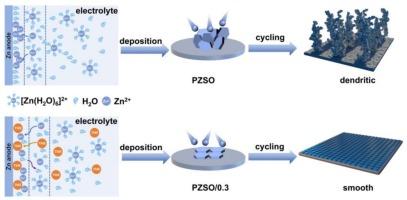三甲基乙烷介导的无枝晶锌阳极电双层工程。
IF 9.7
1区 化学
Q1 CHEMISTRY, PHYSICAL
引用次数: 0
摘要
电解质添加剂是稳定锌离子电池中锌阳极和锌界面的关键策略。然而,常规添加剂通常会同时影响双电层(EDL)和Zn2+的溶剂化鞘层,导致机理解释不明确。在这里,我们引入了三甲基乙烷(TME)作为添加剂,选择性地修饰EDL结构,而不改变Zn2+溶剂化结构,从而精确地阐明了EDL介导的阳极稳定。TME比水分子更优先吸附在锌阳极表面,实现双功能调节:减少Zn(101)晶面对Zn2+的吸附,同时增强Zn(002)晶面对Zn2+的吸附,从而促进Zn2+均匀分布。更重要的是,TME分子穿透EDL形成稳定的缺水界面,减少活性H2O分子,抑制寄生反应。同时,edl嵌入的TME增加了锌离子成核过电位,创造了丰富的成核位点,促进了致密、无枝晶锌矿床的形成。添加TME的Zn||锌对称电池在1ma cm-2 (1mah cm-2)下的循环寿命可达1495小时,优于大多数报道的电解质系统。这项工作为edl导向的电解质工程建立了一个新的范例,为下一代高性能azib的合理设计提供了重要的见解。本文章由计算机程序翻译,如有差异,请以英文原文为准。

Trimethylolethane-mediated electric double layer engineering for dendrite-free zinc anodes
Electrolyte additives are a key strategy for stabilizing zinc anodes and interfaces in aqueous zinc ion batteries (AZIBs). However, conventional additives often affect both the electric double layer (EDL) and the solvated sheath of Zn2+, resulting in ambiguous mechanistic interpretations. Here, we introduce trimethylolethane (TME) as an additive that selectively modifies the EDL architecture without altering the Zn2+ solvation structure, enabling precise elucidation of EDL-mediated anode stabilization. TME preferentially adsorbs onto the zinc anode surface over water molecules, enabling dual-functional regulation: it reduces Zn2+ adsorption on the Zn (101) crystal facet while enhancing adsorption on the Zn (002) facet, thereby promoting uniform Zn2+ distribution. More importantly, TME molecules penetrate the EDL to form a stable, water-deficient interface, reducing active H2O molecules and suppressing parasitic reactions. Concurrently, the EDL-embedded TME increases zinc ion nucleation overpotential, creating abundant nucleation sites and promoting the formation of compact, dendrite-free Zn deposits. The Zn||Zn symmetric cell with TME additive remarkably achieved a cycle life of up to 1495 h at 1 mA cm−2 (1 mAh cm−2), outperforming most reported electrolyte systems. This work establishes a new paradigm in EDL-oriented electrolyte engineering, providing critical insights for the rational design of next-generation high-performance AZIBs.
求助全文
通过发布文献求助,成功后即可免费获取论文全文。
去求助
来源期刊
CiteScore
16.10
自引率
7.10%
发文量
2568
审稿时长
2 months
期刊介绍:
The Journal of Colloid and Interface Science publishes original research findings on the fundamental principles of colloid and interface science, as well as innovative applications in various fields. The criteria for publication include impact, quality, novelty, and originality.
Emphasis:
The journal emphasizes fundamental scientific innovation within the following categories:
A.Colloidal Materials and Nanomaterials
B.Soft Colloidal and Self-Assembly Systems
C.Adsorption, Catalysis, and Electrochemistry
D.Interfacial Processes, Capillarity, and Wetting
E.Biomaterials and Nanomedicine
F.Energy Conversion and Storage, and Environmental Technologies

 求助内容:
求助内容: 应助结果提醒方式:
应助结果提醒方式:


